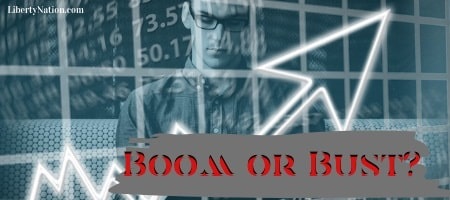In the classic 1953 French picture, The Wages of Fear, an oil company hires four men to deliver supplies of nitroglycerine in two trucks. The cinematic masterpiece exhibits human emotion at its highest of highs and lowest of lows, from heart-stopping raw emotion to dramatic tension. When the characters navigate through tight roads, avoid the slightest of bumps, and successfully refrain from being blown up, the anxiety is unbearable and your adrenaline is through the roof. Eventually, reality intervenes and (spoiler alert) everyone dies. This is comparable to the market crash that has wiped out trillions of dollars worldwide after more than a decade of unprecedented euphoria and ecstasy.
Throughout the duration of the economy’s bull market, investors have avoided the bumps in the road and celebrated with dramatic gains. When traders met a roadblock, everything exploded.
Champagne Before the Coronapocalypse
 In the aftermath of the Great Recession, the Federal Reserve unleashed a historic and unconventional stimulus program that consisted of low interest rates, hundreds of billions of dollars in asset purchases, and debt monetization. The deities inside the Eccles Building successfully made investors forget about the economic collapse by giving birth to a new generation of New York Stock Exchange junkies addicted to easy money. They routinely sought new highs from the freshly printed money from the magical machine resting in the vaults of the U.S. central bank.
In the aftermath of the Great Recession, the Federal Reserve unleashed a historic and unconventional stimulus program that consisted of low interest rates, hundreds of billions of dollars in asset purchases, and debt monetization. The deities inside the Eccles Building successfully made investors forget about the economic collapse by giving birth to a new generation of New York Stock Exchange junkies addicted to easy money. They routinely sought new highs from the freshly printed money from the magical machine resting in the vaults of the U.S. central bank.
The monetary expansion triggered a unique bull market. A handful of trillion-dollar valuations, unprofitable companies filing initial public offerings (IPOs), and the Dow Jones Industrial Average climbing approximately 20,000 points – it has been nothing but champagne, Grey Poupon, and caviar. Although more than half the country possesses stocks, equities had become a bit too expensive for some people to buy into. The coronapocalypse happened and suddenly there are buying opportunities everywhere – or are there?
Once the Wuhan Coronavirus outbreak happened in the United States, the market capitalization spikes and the enormous index gains under President Donald Trump were wiped out in just a few days. Nobody knows when the market crash will bottom out, but institutional and retail investors are trying to catch falling knives for the discounts in some of the biggest finance and technology companies that had been trading at record highs before the historical market event.
But are there discounts to be had with the likes of Amazon, Apple, or Alphabet? That is the problem with asset price inflation spurred by years of money-printing: Everything is distorted. Who knows what something is worth anymore? And that is why the February-March crash was so monumental. The century-old institution primed the pump.
It is unclear if you are buying a dip or paying for these companies’ real value. When the Fed prints money, it is those closest to the spigot who will imbibe the benefits. In this case, the real estate, finance, and technology industries have benefited the most during the Fed-induced boom phase of the business cycle. The same trends will occur during the next bull run.
Prior to the recession, Amazon was trading at around $60. By February 2020, the stock topped $2,000. After the market crash, shares tumbled just below $2,000. Apple stock cost you around $30 more than ten years ago, surging to as high as $327. Despite the outbreak’s impact on its operations, Apple is only down to around $250. You could have gotten Goldman Sachs at a huge discount of $70 before it soared to $250. The Wall Street titan has had a rough couple of years with its putrid forecasts, plus it has not been immune to the virus. And yet, the bank is trading where it was in 2016: $160.
Most will make the argument that these companies’ fundamentals are sound, their stock performance is indicative of how excellent their businesses are run, and it is what investors are willing to pay. Others will say these stocks are examples of asset price inflation spawned by Fed policy. Who is right?
Asset Price Inflation
Asset price inflation happens when there is an exponential increase in stocks, bonds, derivatives, and other investment instruments.
The enormous jump since 2009 can be attributed to the multiple editions of quantitative easing – buying long-term securities to drive down interest rates and boost the money supply. In recent months, the U.S. central bank and the gatekeepers of allowable opinion in the business press have conceded that monetary policy is the driver of asset prices, which was something unheard of just a few years ago. As they say, it is better late than never.
While the good times seemed to be rolling, a huge sneeze made everything on Wall Street contract the flu. Or, in this case, COVID-19. Everything the Fed did was for naught as the unconventional tools of ZIRP and bailouts contributed to largesse, a market that had significant premiums in a treasure trove of stocks. If you wanted to own Netflix or JPMorgan Chase, you had to pay a double-digit premium for the privilege. Is this normal for a stock market? Well, if the latest trends tell you anything, it is that everything is abnormal under present conditions.
Unless you can travel back in time and prevent the Fed from intervening into markets, it is unknown what would have happened on Wall Street in the absence of Ben Bernanke, Janet Yellen, and Jerome Powell. If there would have been a recovery and everything functioned as normal without skyrocketing gains, it is unlikely that the market would behave the way it has in recent weeks.
In other words, without the Fed-driven asset price inflation, you probably would not experience 3,000-point losses one day and 2,100-point gains the next. You would see shedding, but it wouldn’t erase everything that has accrued since January 2017.
Big Bazookas
When President Donald Trump said that the U.S. stock will roar again, he was probably correct.
It is inevitable that the Fed’s firing of its big bazookas will trigger a tsunami of price inflation across the entire economy, especially if trade with China decreases. Ditto for equities. The Facebooks, the Teslas, and the Wells Fargos may have taken a beating over the last month, but they will return to their all-time highs once the COVID-19 panic dies down. That is, until the real bust in the business cycle happens – and there will be no way the Federal Reserve could bail out Wall Street again without a dollar collapse.
~
Read more from Andrew Moran.
For home study students and young people, Liberty Nation recommends…
All About Recessions
High School: Recession: The Pros and Cons of the Economic Downturn
Middle School: The Pros and Cons of Recessions
Elementary School: What is a Recession?
All About Bubbles
High School: Bubblemania: Understanding Bubbles and Their Consequences
Middle School: Bubblemania: The Great American Everything Bubble
Elementary School: What Is a Bubble?




